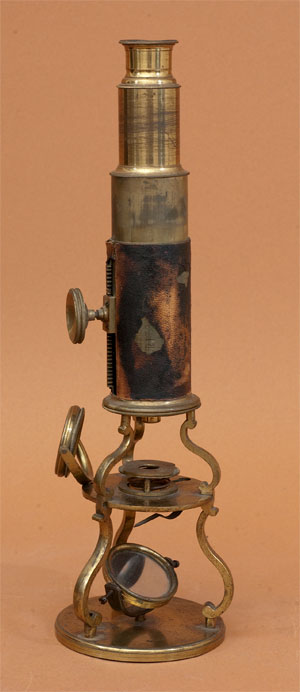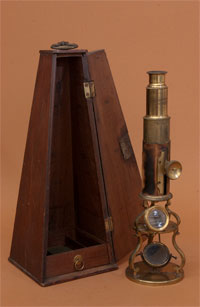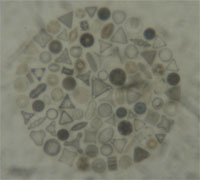 |
|||||
 |
 |
||||
 |
|||||
 |
 |
||||
Culpeper-style, Brass Compound Microscope (No. 69) |
|||||||||
 |
Age: 1790-1810 Made by: unknown Made in: probably England |
||||||||
 |
|||||||||
|
Mahogany storage case
|
|||||||||
 |
|||||||||
|
Imaging
|
|||||||||
|
This instrument is a Culpeper-style, brass compound monocular microscope. It is a fine example of a popular type of compound microscope made during the beginning of the 19th Century. Microscopes like this were "intended for the pleasure of the leisured classes who desired to use them to interest and amuse their guests."*. This style is an evolutionary step from the true Culpeper of 75–100 years earlier. It differs in having better optics and a much more precise focusing mechanism. This instrument has a body tube covered with natural-colored leather or shark skin (now degraded). It is 27cm high with a brass base 8.25cm in diameter. Focusing is coarse only, with a rackwork mechanism mounted on an outer cylinder. This microscope has only one objective remaining (stamped "3"). The objective can be removed from the tapered body tube. The stage has a circular insert on top to accommodate a Bonanni specimen holder, and clips below to hold a live box or glass phial. It also has a keyhole-shaped slot where a fish plate or stage forceps was probably mounted. All accessories are now missing. The optical path is the typical three-lens system of objective, field lens, and eyepiece. Magnification is approximately 20x (total) using the #3 objective lens. Imaging suffers from low light gathering and spherical aberration. This microscope has two illumination devices: a substage mirror and an epi-illumination lens ("bull's-eye"). The microscope can be stored in its wooden pyramidal case. The microscope is similar to a Dixey microscope (#17, 1825–37) in the RMS collection. *Clay and Court. 1932. The History of the Microscope. Featured 5/2005; 9/2010; 07/2020 |
|||||||||